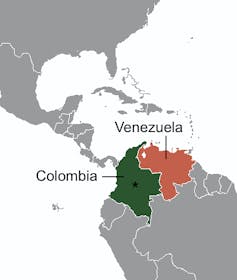Violence and killings haven't stopped in Colombia despite landmark peace deal
A 2016 accord with the FARC guerrillas was supposed to end Colombia's 52-year civil war. But a deadly car bomb in Bogotá shows that armed insurgents still threaten the South American country.
A deadly car bomb at a Bogotá police academy claimed by Colombia’s National Liberation Army, or ELN, is the latest sign that Colombia’s civil war is not over. President Ivan Duque called the January attack, which killed 21 military personnel and wounded 68, a “crazy terrorist act.”
The leftist ELN became Colombia’s largest guerrilla group after the Revolutionary Armed Forces of Colombia, or FARC, disbanded following a peace agreement with the government in September 2016.
As I write in my new book on the counter-insurgency efforts leading up to the peace deal, there were already clear signs that neutralizing the FARC would not end Colombia’s 52-year armed conflict.
A complex conflict
What Colombians call “el conflicto” – the conflict – was never a simple two-way fight of everyone versus the FARC. It was, and remains, a set of overlapping and interrelated conflicts involving the government, Marxist rebels, right-wing militias and drug cartels, staggered across the decades from 1964 to today.
The 2016 FARC deal was a historic achievement. After its signing, armed conflict-related fatalities in Colombia dropped from about 3,000 a year to just 78.

But an ever-changing array of criminal gangs still operate in Colombia, profiting off drug production, illegal mining and extortion. The landscape of their territorial control has simply changed, with the ELN, Autodefensa Gaitanista de Colombia and other armed groups spreading into areas once run by the FARC.
Other political violence has ticked up since the 2016 accord, too, including the targeted killing of indigenous and Afro-Colombian activists.
The FARC is not entirely defunct, either.
Colombian research groups Fundación Ideas para la Paz and Insight Crime report that ever more former fighters are dissatisfied with the FARC’s reincarnation as a political party. Up to 3,000 guerrillas – one-quarter of the roughly 12,000 demobilized after the peace accord – have re-armed alongside their former comrades.
Others have joined the ELN, which has doubled in size since the FARC’s disarmament.
January’s car bombing was a show of force.
Colombia’s tense border

The attack likely snuffs out any chance of a peace deal with the ELN, which Colombia’s government has pursued for years.
The ELN is primarily active along the Colombia-Venezuela border. If Colombia’s government cracks down on the group, violence could escalate quickly.
Venezuela’s Nicolás Maduro is in a power struggle to save his embattled presidency, and the U.S. has threatened military intervention. That would probably involve using Colombian territory as an operations base.
Colombia’s border region is a tinderbox of geopolitical tension. A flare-up with the ELN may be the spark that sets it off.
Alexander L Fattal has received funding from the National Science Foundation, Social Science Research Council, and Wenner-Gren Foundation.
Read These Next
Oldest known cremation in Africa poses 9,500-year-old mystery about Stone Age hunter-gatherers
An ancient cremation would have been a community spectacle in a place returned to and reignited over…
Has the Fed fixed the economy yet? And other burning economic questions for 2026
As 2026 begins, uncertainty is at the top of everyone’s mind.
Midlife weight gain can start long before menopause – but you can take steps early on to help your b
What you do in the years leading up to menopause can help counter the natural hormonal effects of aging,…






